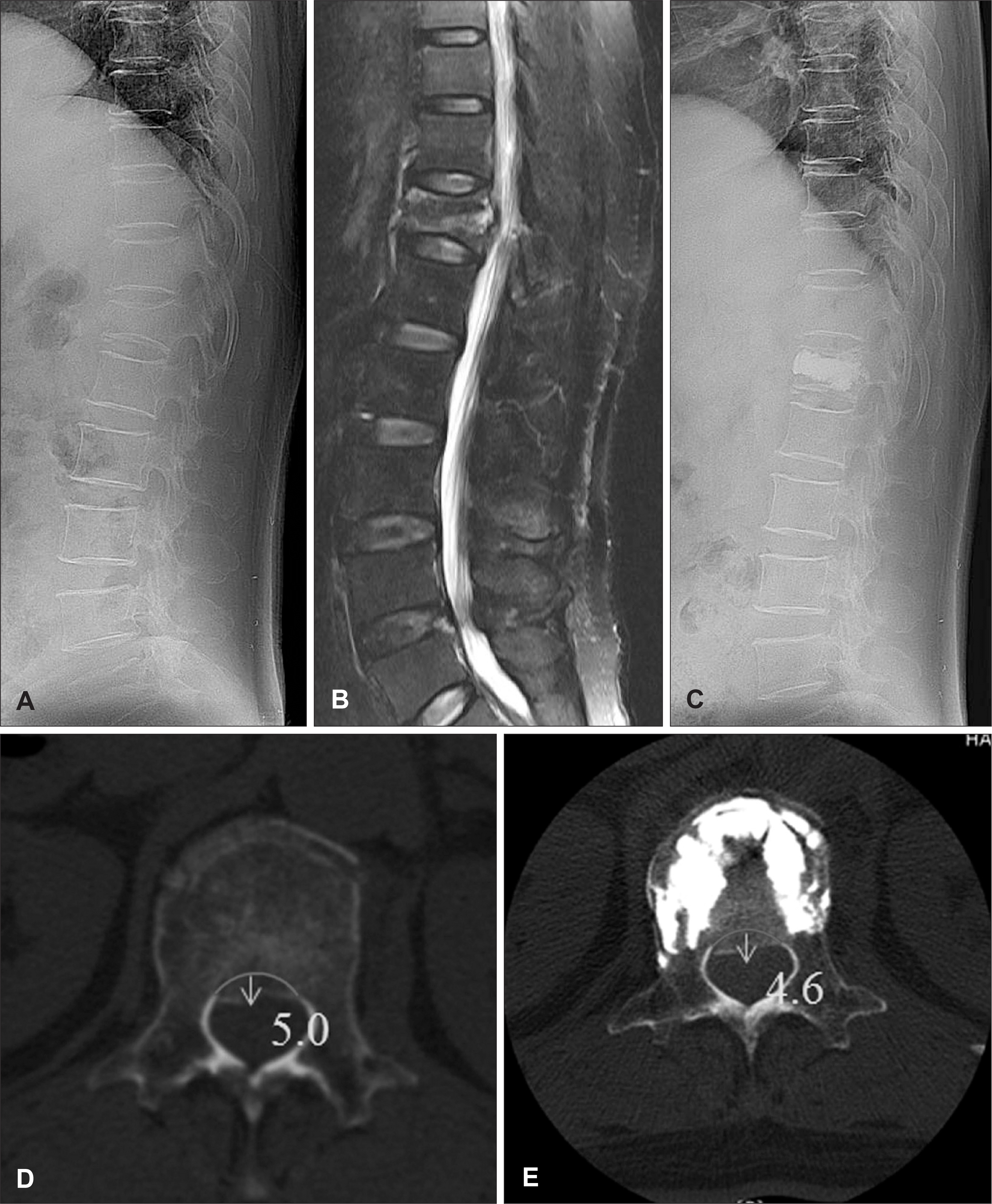Abstract
Objective:
Percutaneous vertebroplasty is a minimally invasive procedure to relieve or decrease pain in patients with osteoporotic compression fractures. However, vertebroplasty in the osteoporotic burst fracture patients with preoperative canal encroachment are still being debated, because it can aggravate spinal canal encroachment. The objects of this study is evaluation of the changes in spinal canal narrowing after percutaneous vertebroplasty.
Methods:
Inclusion criteria was osteoporotic bursting fracture patients with 5 to 20% canal encroachment (less than 5 mm). Exclusion criteria included pathological fractures, unstable vertebral fractures involving the posterior column, and severe neurological deficit. We measured the changes in spinal canal narrowing by pre- and postoperative computed tomography. Degree of canal encroachment was measured as the distance between the imaginary line along the posterior margin of the bony fragment and the maximal anterior imaginary line of the spinal canal in the axial CT scan.
Results:
This study was based on 10 patients (1 male and 9 female; age range, 52-89 years; mean age, 75 years). The mean decrease in the compression rate of the vertebral body height was 14.4% (43.4% to 29%). The mean decrease in the kyphotic angle was 4.3° (11.7° to 7.4°). The mean preoperative canal encroachment were 3.5 mm and postoperative canal encroachment was 3.7 mm, respectively. The mean preoperative VAS score was 4.3 and postoperative VAS score was 1.4.
Go to : 
REFERENCES
1). Appel NB., Gilula LA. Percutaneous vertebroplasty in patients with spinal canal compromise. AJR Am J Roentgenol. 182:947–951. 2004.

2). Carlier RY., Gordji H., Mompoint DM., Vernhet N., Feydy A., Vallée C. Osteoporotic vertebral collapse: percutaneous vertebroplasty and local kyphosis correction. Radiology. 233:891–898. 2004.

3). Chen YJ., Tan TS., Chen WH., Chen CC., Lee TS. Intradural cement leakage: a devastatingly rare complication of vertebroplasty. Spine (Phila Pa 1976) 31: E379-E382. 2006.
4). Cotten A., Boutry N., Cortet B., Assaker R., Demondion X., Leblond D, et al. Percutaneous vertebroplasty: state of the art. Radiographics. 18:311–320. discussion 320-323. 1998.

5). Cotten A., Dewatre F., Cortet B., Assaker R., Leblond D., Duques-noy B, et al. Percutaneous vertebroplasty for osteolytic metastases and myeloma: effects of the percentage of lesion filling and the leakage of methyl methacrylate at clinical follow-up. Radiology. 200:525–530. 1996.

6). Deramond H., Depriester C., Galibert P., Le Gars D. Percutaneous vertebroplasty with polymethylmethacrylate. Technique, indications, and results. Radiol Clin North Am. 36:533–546. 1998.
7). Dimar JR 2nd., Wilde PH., Glassman SD., Puno RM., Johnson JR. Thoracolumbar burst fractures treated with combined anterior and posterior surgery. Am J Orthop (Belle Mead NJ). 25:159–165. 1996.
8). Dublin AB., Hartman J., Latchaw RE., Hald JK., Reid MH. The vertebral body fracture in osteoporosis: restoration of height using percutaneous vertebroplasty. AJNR Am J Neuroradiol. 26:489–492. 2005.
9). Galibert P., Deramond H., Rosat P., Le Gars D. [Preliminary note on the treatment of vertebral angioma by percutaneous acrylic vertebroplasty]. Neurochirurgie. 33:166–168. 1987.
10). Harrington KD. Major neurological complications following percutaneous vertebroplasty with polymethylmethacrylate: a case report. J Bone Joint Surg Am 83-A: 1070-1073. 2001.
11). Hiwatashi A., Moritani T., Numaguchi Y., Westesson PL. Increase in vertebral body height after vertebroplasty. AJNR Am J Neuroradiol. 24:185–189. 2003.
12). Hiwatashi A., Sidhu R., Lee RK., deGuzman RR., Piekut DT., Westesson PL. Kyphoplasty versus vertebroplasty to increase vertebral body height: a cadaveric study. Radiology. 237:1115–1119. 2005.

13). Jensen ME., Dion JE. Percutaneous vertebroplasty in the treatment of osteoporotic compression fractures. Neuroimaging Clin N Am. 10:547–568. 2000.
15). Lee ST., Chen JF. Closed reduction vertebroplasty for the treatment of osteoporotic vertebral compression fractures. Technical note. J Neurosurg 100(4 Suppl Spine): 392-396. 2004.
16). Martin JB., Jean B., Sugiu K., San Millán Ruíz D., Piotin M., Murphy K, et al. Vertebroplasty: clinical experience and follow-up results. Bone 25(2 Suppl): 11S-15S. 1999.

17). Mathis JM., Petri M., Naff N. Percutaneous vertebroplasty treatment of steroid-induced osteoporotic compression fractures. Arthritis Rheum. 41:171–175. 1998.

18). McKiernan F., Jensen R., Faciszewski T. The dynamic mobility of vertebral compression fractures. J Bone Miner Res. 18:24–29. 2003.

19). Peh WC., Gilula LA., Peck DD. Percutaneous vertebroplasty for severe osteoporotic vertebral body compression fractures. Radiology. 223:121–126. 2002.

20). Peters KR., Guiot BH., Martin PA., Fessler RG. Vertebroplasty for osteoporotic compression fractures: current practice and evolving techniques. Neurosurgery 51(5 Suppl): S96-S103. 2002.

21). Rahamimov N., Mulla H., Shani A., Freiman S. Percutaneous augmented instrumentation of unstable thoracolumbar burst fractures. Eur Spine J. 21:850–854. 2012.

22). Ratliff J., Nguyen T., Heiss J. Root and spinal cord compression from methylmethacrylate vertebroplasty. Spine (Phila Pa 1976) 26: E300-E302. 2001.

23). Teng MM., Cheng H., Ho DM., Chang CY. Intraspinal leakage of bone cement after vertebroplasty: a report of 3 cases. AJNR Am J Neuroradiol. 27:224–229. 2006.
24). Teng MM., Wei CJ., Wei LC., Luo CB., Lirng JF., Chang FC, et al. Kyphosis correction and height restoration effects of percutaneous vertebroplasty. AJNR Am J Neuroradiol. 24:1893–1900. 2003.
25). Tsai TT., Chen WJ., Lai PL., Chen LH., Niu CC., Fu TS, et al. Polymethylmethacrylate cement dislodgment following percutaneous vertebroplasty: a case report. Spine (Phila Pa 1976) 28: E457-E460. 2003.

Go to : 
 | FIGURE 1.A: 73-year-old female patient had a burst fracture of T12 on initial plain film. B: magnetic resonance image T2 weighted image shows the collapsed vertebra with canal encroachment. C: After the percutaneous vertebroplasty, the height of the vertebral body was increased and kyphotic angle was decreased. D: Encroachment of the bone fragment was measured in the axial plane by using a distance from the line between the posterior margin of the bony fragment and maximal anterior imaginary line of the spinal canal in axial computed tomography scan. E: After the percutaneous vertebroplasty, there is no exacerbation with canal encroachment. |




 PDF
PDF ePub
ePub Citation
Citation Print
Print


 XML Download
XML Download